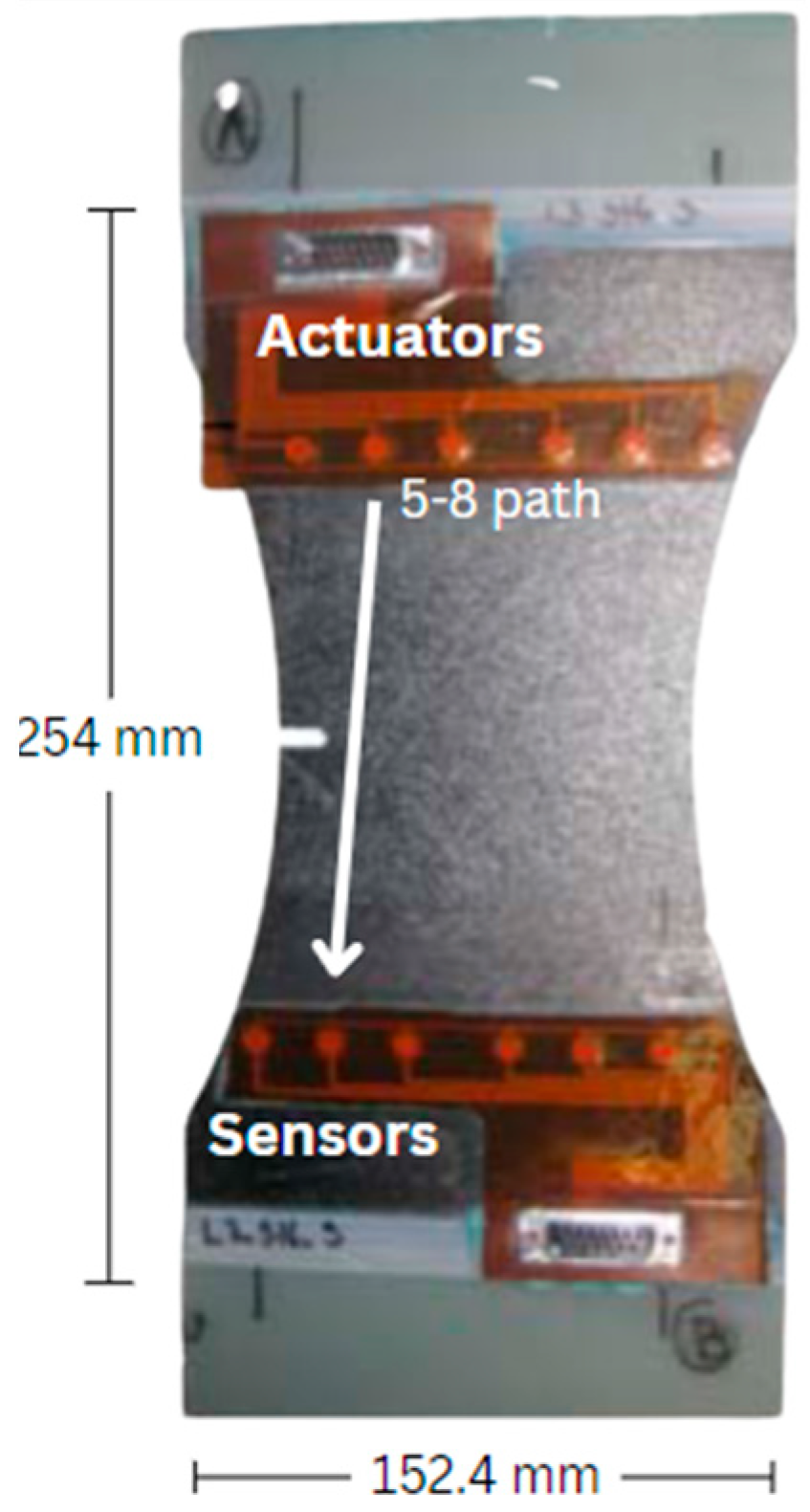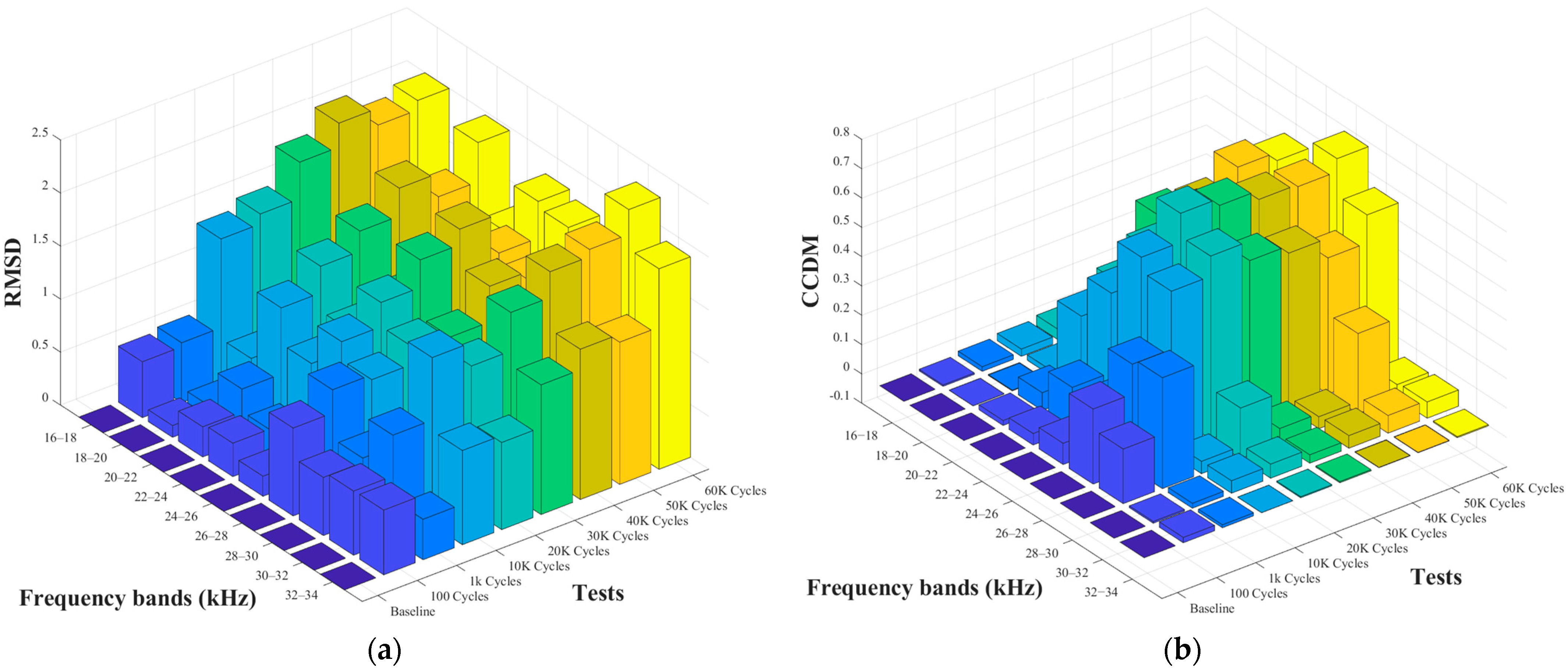Method for Damage Detection of CFRP Plates Using Lamb Waves and Digital Signal Processing Techniques †
Abstract
1. Introduction
2. Materials and Methods
Proposed Methodology
3. Results and Discussion
3.1. Time-Domain Analysis
3.2. Frequency-Domain Analysis
3.3. Damage Indices
4. Conclusions
Author Contributions
Funding
Institutional Review Board Statement
Data Availability Statement
Conflicts of Interest
References
- Wilson, C.L.; Chang, F.K. Monitoring fatigue-induced transverse matrix cracks in laminated composites using built-in acousto-ultrasonic techniques. Struct. Health Monit. 2016, 15, 335–350. [Google Scholar] [CrossRef]
- Callister, W.D., Jr.; Rethwisch, D.G. Materials Science and Engineering: An Introduction; Wiley: New York, NY, USA, 2020. [Google Scholar]
- Larrosa, C.C.; Lonkar, K.; Shankar, S.; Chang, F.-K. Damage Classification in Composite Laminates: Matrix Micro-Cracking and Delamination. Available online: http://dpi-proceedings.com/index.php/shm2011/article/view/22247 (accessed on 7 July 2022).
- Teti, R.; Segreto, T.; Caggiano, A.; Nele, L. Smart multi-sensor monitoring in drilling of CFRP/CFRP composite material stacks for aerospace assembly applications. Appl. Sci. 2020, 10, 758. [Google Scholar] [CrossRef]
- Hanser, S.; Ferrer, G.; Dupouy, S. Keeping in shape A350 structure repairs and kits. Available online: https://aircraft.airbus.com/sites/g/files/jlcbta126/files/2021-11/FAST-article-Keeping-in-shape-November-2021.pdf (accessed on 7 July 2022).
- Tavares, S.M.O.; de Castro, P.M.S.T. An overview of fatigue in aircraft structures. Fatigue Fract. Eng. Mater. Struct. 2017, 40, 1510–1529. [Google Scholar] [CrossRef]
- Rocha, H.; Semprimoschnig, C.; Nunes, J.P. Sensors for process and structural health monitoring of aerospace composites: A review. Eng. Struct. 2021, 237, 112231. [Google Scholar] [CrossRef]
- Güemes, A.; Fernandez-Lopez, A.; Pozo, A.R.; Sierra-Pérez, J. Structural health monitoring for advanced composite structures: A review. J. Compos. Sci. 2020, 4, 13. [Google Scholar] [CrossRef]
- Saxena, A.; Goebel, K.; Larrosa, C.C.; Janapati, V.; Roy, S.; Chang, F.K. Accelerated aging experiments for prognostics of damage growth in composite materials. In Proceedings of the 8th International Workshop on Structural Health Monitoring, Stanford, CA, USA, 13–15 September 2013; Volume 1, pp. 1283–1291. [Google Scholar]
- Larrosa, C.; Lonkar, K.; Chang, F.K. In situ damage classification for composite laminates using Gaussian discriminant analysis. Struct. Health Monit. 2014, 13, 190–204. [Google Scholar] [CrossRef]
- Chiachío, J.; Chiachío, M.; Saxena, A.; Rus, G.; Goebel, K. An energy-based prognostic framework to predict fatigue damage evolution in composites. In Proceedings of the Annual Conference of the Prognostics and Health Management Society, New Orleans, LA, USA, 14–17 October 2013; pp. 363–371. [Google Scholar]
- Corbetta, M.; Sbarufatti, C.; Giglio, M.; Saxena, A.; Goebel, K. A Bayesian framework for fatigue life prediction of composite laminates under co-existing matrix cracks and delamination. Compos. Struct. 2018, 187, 58–70. [Google Scholar] [CrossRef]
- Corbetta, M.; Saxena, A.; Giglio, M.; Goebel, K. Evaluation of multiple damage-mode models for prognostics of carbon fiber-reinforced polymers. In Proceedings of the 10th International Workshop on Structural Health Monitoring—IWSHM 2015, Stanford, CA, USA, 1–3 September 2015; Volume 2, pp. 609–616. [Google Scholar] [CrossRef]
- Junior, P.; D’addona, D.M.; Aguiar, P.R.; Teti, R. Dressing tool condition monitoring through impedance-based sensors: Part 1—PZT diaphragm transducer response and emi sensing technique. Sensors 2018, 18, 4455. [Google Scholar] [CrossRef] [PubMed]





Publisher’s Note: MDPI stays neutral with regard to jurisdictional claims in published maps and institutional affiliations. |
© 2022 by the authors. Licensee MDPI, Basel, Switzerland. This article is an open access article distributed under the terms and conditions of the Creative Commons Attribution (CC BY) license (https://creativecommons.org/licenses/by/4.0/).
Share and Cite
Monson, P.; Junior, P.O.C.; Rodrigues, A.R.; Aguiar, P.; Junior, C.S. Method for Damage Detection of CFRP Plates Using Lamb Waves and Digital Signal Processing Techniques. Eng. Proc. 2022, 27, 42. https://doi.org/10.3390/ecsa-9-13357
Monson P, Junior POC, Rodrigues AR, Aguiar P, Junior CS. Method for Damage Detection of CFRP Plates Using Lamb Waves and Digital Signal Processing Techniques. Engineering Proceedings. 2022; 27(1):42. https://doi.org/10.3390/ecsa-9-13357
Chicago/Turabian StyleMonson, Paulo, Pedro Oliveira Conceição Junior, Alessandro Roger Rodrigues, Paulo Aguiar, and Cristiano Soares Junior. 2022. "Method for Damage Detection of CFRP Plates Using Lamb Waves and Digital Signal Processing Techniques" Engineering Proceedings 27, no. 1: 42. https://doi.org/10.3390/ecsa-9-13357
APA StyleMonson, P., Junior, P. O. C., Rodrigues, A. R., Aguiar, P., & Junior, C. S. (2022). Method for Damage Detection of CFRP Plates Using Lamb Waves and Digital Signal Processing Techniques. Engineering Proceedings, 27(1), 42. https://doi.org/10.3390/ecsa-9-13357






